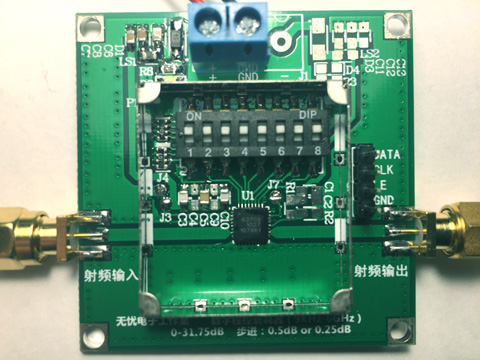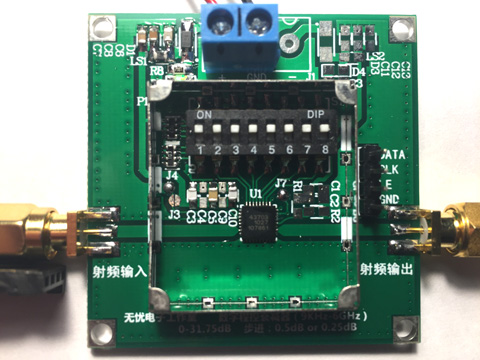Output Attenuator
Introduction
It is possible to add a programmable output level attenuator to the Portsdown transmitter. The output attenuator can be used to adjust the output level of the Portsdown Transmitter and Signal Generator and allows programmable output levels to be set for each band and additional transverter outputs.
Attenuator Types
Attenuators based on the PE4302, PE4312, HMC1119, PE43703 or PE43713 are supported. The PE4302, PE4312 and PE43703 types are readily available on eBay for under £20. The preferred type is the PE43703 illustrated here with its screening cover removed:
Data sheets are available at these links:
http://www.psemi.com/pdf/datasheets/pe4302ds.pdf http://www.psemi.com/pdf/datasheets/pe43703ds.pdf http://www.analog.com/media/en/technical-documentation/data-sheets/HMC1119.pdf.
Preparation
As supplied, the eBay pre-built attenuator boards are generally configured for control by DIP switches, not by a Raspberry Pi. NOTE THAT IF CONNECTED WITHOUT MODIFICATION THEY MAY KILL YOUR RASPBERRY PI!
PE43703
There are 3 signal lines used to program the PE43703: LE (Latch Enable), CLK (Clock) and Data. For DIP switch programming the LE line is connected to +5v. This line needs to be disconnected from +5v otherwise it will try to put 5v on a 3.3v RPi GPIO output. Referring to the picture below (pre-modification):
The solder blob at J7 connects the LE line to +5v. This blob needs to be sucked or solder-wicked away (taking the usual anti-static precautions). Afterwards, check with a test meter that there is no remaining connection between the 2 halves.
There is also a parallel/serial switch line that is initially set to parallel (+5v). To set it to serial (0v), remove the blob at J4, and create a new blob at J3. Check that J4 has really been disconnected! The top picture on this page shows the unit after modification.
Apply power (5v) to the unit. If all is well, the power LED should light; if not, recheck J4. Then check the voltage on the DATA, CLK and LE pins. They should all be at 0v. Using a 1K resistor, check that each of them can be pulled up to 5v. Only after these checks is it safe to start making connections to the RPi.
PE4302
The PE4302 uses the same three signal lines as the PE43703. Details of how to configure the board for serial control can be found here: https://wiki.batc.org.uk/PE4302
PE4312
The PE4312 module uses the same three signal lines as the PE4302. Details of how to configure the board for serial control can be found here: https://wiki.batc.org.uk/PE4302.
Data Connections to the Raspberry PI
The attenuator shares the clock and data lines used by the ADF4351 synthesizer. A separate LE line is used, connected to Pin 10 of the GPIO connector. This pin can be accessed from the "DigiThin" connector on the Portsdown GPIO board.
During testing of the PE43703, it has been found that connecting the attenuator board can cause the ADF4351 to fail to start; the ADF4351 seems to be particularly fussy about the rise times on its programming signals. To overcome this problem, and to prevent any possible damage to the Raspberry Pi from the +5v present on the attenuator board, it is recommended that the 3 signal lines to the attenuator are connected through 1K resistors. The connections are as follows (use the physical pin numbers):
| Signal | GPIO Physical Pin | BCM No | Wiring Pi | Notes |
|---|---|---|---|---|
| LE | 10 | 15 | 16 | through 1K from DigiThin Connector |
| CLK | 29 | 5 | 21 | through 1K from ADF4351 CLK |
| DATA | 31 | 6 | 22 | through 1K from ADF4351 DATA |
RF Connections
The attenuator should be wired between the RF output of the Filter-modulator board [or Lime SDR] and the input to the 4-way (or 8-way) switch. That way it will be in-circuit on all bands. The attenuator level can be set and stored for each band independently for use with the Portsdown DATV transmitter.
It could also be placed directly on the second output of the ADF4351, and the signal generator software allows for this. However, this is for a direct output, and will not work as a means of altering the output level from the Portsdown filter-modulator.
RF Switching
When the Portsdown output of the Signal Generator is in use without modulation, the output is always fed through the 23 cms output of the 4-way switch. This is because it is the port with the lowest loss and provides the full frequency coverage from a single port.
However, if modulation is selected on the Portsdown Signal Generator, the output is fed to the appropriate output port for the frequency selected. There are 2 reasons that this design decision was made: firstly, the mode is intended for adjusting drive levels to transmitters, so it seems logical to use the output connection appropriate for the transmitter; secondly, to generate a high quality DVB-S signal, the appropriate LO filter needs to be switched into circuit, and the filters are switched by the same lines as the output port switch.
Attenuator Loss
When the attenuator is set to 0dB, it has an insertion loss of about 2dB (increasing at higher frequencies). This loss is always additive, so that when set to 31dB the actual loss is 33dB.

